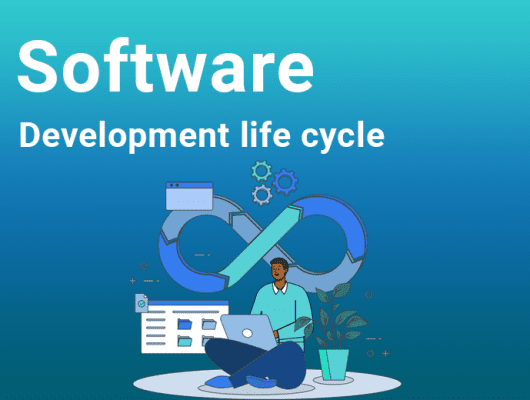
Key Considerations for Successful Mobile App Development
Mobile app development is an intricate process that leaves a lot of complexity behind.
So, to make it a success, there is a need for careful consideration and strategic planning. From conceptualization to launch and beyond, key factors can make or break your app’s performance and user satisfaction.
But what are these crucial considerations? How do you navigate the complexities of platforms for successful mobile app development?
Looking for the answer to these questions, well here is an ultimate guide for you.
This article is all about how to develop enterprise software that can simplify your organization processes.
Therefore, without wasting time, let’s dig deeper into it.
Table of Contents
1. How To Make a Successful Mobile App?

For the successful development of a mobile app, three aspects are essential, i.e.
- The target audience
- Market
- Product itself.
These factors combine to provide users with high-quality performance, usability and designs.
But how can one ensure that their app will be a hit? Two broad types of features make a mobile app successful: consumer-centric qualities and business-centric qualities.
1.1. Attributes Focused on the Customer
To make you app customer centric, here are the few features to consider
- Both aesthetically pleasing and functionally optimized product designs are essential for better user experience .
- High-quality UX and UI.
- Understanding user demands and needs from a service
- Dependable and steady process flow
- Offers an adequate degree of data security
- Provides easy means of contacting client service
- Lastly, consider digital accessibility in mind so users of all abilities and backgrounds may access and utilize the app without assistance.
1.2. Features Centered on the business
A business-focused mobile app should have these essential features:
- Aids in attracting and retaining users.
- Provides easy, fast payment processing (if the app needs that functionality)
- Prevents unauthorized access to files
- Economical in terms of upkeep and potential growth
2. Understanding The Type For Successful Mobile App Development
According to Statista Digital Market, the number of mobile applications will increase by 2025 to 500-600 billion USD. Consequently, various apps are becoming a part of this software market. These varieties of app include
| Type of the Mobile Applications | Pros | Cons |
| Native App | Apps that are installed directly on your mobile, either from the Google Play Store or the Apple App Store. These apps have ability to run without internet | Not budget friendly Consume a lot of time to market Demand frequent updates. |
| Cross Platform app | Single code development User can effortlessly install it on Android or Apple devices Highly affordable Consume less time to develop Seamless maintenance and updates | Not easy to deploy new updates and features Need of regular maintenance Less security |
| Hybrid App | Just like the cross platform apps, these app are design using single code Users can install it on different platforms, e.g., iOS and Android Do not require extensive technical knowledge to develop High user interface | Not good to use on the out dates mobile phones Limited nature |
| Progressive Web app | Highly cost effective Easy to maintain Due to its cross platform nature, users can easily access it on various platforms These apps have ability to work offline as well High UX/UI interfaces | Users have to access these apps from the web Do not provide options to download it from apple store or google play store Contain less functions |
3. Things To Consider For Successful Mobile App Development

Want to get a four-star and five-star review on your application, but it seems impossible? In a world where every solution comes from technology, getting a 5-star review for your app is not a big deal. All you need to consider are the few essential steps while working on successful mobile app development. These practical tips include
3.1. Market Research
If you want to make your app successful, do extensive research and understand your market needs and trends apart from having proper ideas.
You can gain valuable insight from an analysis of market research by learning about your competitors’ techniques and the market attractiveness. By doing so, you can optimize your app immediately at the start.
Moreover, reading user reviews can provide you with a good idea of what people enjoy, what they prefer, and what they might need in the future. Therefore, note the problematic regions and work on fixing them in your app.
3.2. Understand your Market Audience
Before beginning your process of successful mobile app development, it is essential to establish precise goals for your mobile app. Specify the issues your application will address or the benefits it will deliver to its users.
Determine the requirements, preferences, and pain points of your target audience. This will assist you in developing an app that is specific to your target audience and prioritizes their software needs.
3.3. App Complexity and Design
The app’s design is vital in taking your mobile app from ground to height. The simple, sleek design with less text drives more engagement than the app’s messy look. So, if you ask the reason for successful mobile app development, remember its most straightforward features and minimalist design.
According to mobile app development statistics, about 70% of users stopped using the app due to its complicated and time-consuming features.
Note that the slightest yet the most eye-catching features the application will have, the more it will attract the audience,
3.4. Testing of User Interface and Usability
Testing is another essential feature in successful mobile app development process. Therefore,
Always make sure to test on the following:
- Various handhelds
- Software platforms and their versions
- Locations
- Limitations on bandwidth
- Great demands on available resources
3.5. Performance
You need to aim higher to make your app talk of the town. About 53% of users stopped using the app within 30 days of installation due to its malfunction. Users determine which applications they no longer need or want within a month. Therefore, you must consider the user’s perception of errors and malfunctions.
According to a USA survey, 88% of users would uninstall an application if it contained flaws or malfunctions.
Of the 88% who took the survey, about half (or 51%) said they would likely uninstall the program if they encountered a daily glitch.
Subsequently, 32% of users indicated they would uninstall the app when a problem occurred.
So, make sure that the app you built is flawless because, for customers, the only ones responsible for the error in the app are the app maker, neither the phone maker, nor the internet provider.
3.6. Cost and Budget
For a successful mobile app development there is always a need for investment, expertise, and planning. So, before stepping into the app development process, make a clear budget plan so it won’t be a hassle later.
The primary factors that add up to budget while developing the app are
- Development process itself
- Maintenance
- Application niche
- Updates
- Marketing
- Other app-related expenses can add up quickly.
Find out more about How much does it cost to develop an app in 2024
3.7. App Monetization Strategy
Developing an app without expecting its eventual success is a hopeless endeavor. Therefore, your marketing and monetization strategies should be well-thought-out if you want the app to generate more income.
This income could come from two sources: directly or indirectly.
You can provide services through the app and integrate a payment mechanism to increase sales.
Or, you can use tracking technologies when designing to earn money indirectly. Using this method, you can understand your market more comprehensively, including the trendy layouts, prices, and calls to action.
You can also keep an eye on the most popular products in the market; this will help you allocate your marketing budget more wisely.
3.8. Timeframe
The time of developing an app depends upon its process. The more features and the complex design you choose, the more it will consume time and wise vera.
Here is the estimated time breakdown of the entire app development process.
| Development- Phase | Timeline |
| From generating idea to doing market research | 1 to 4 weeks |
| Designing and prototyping | 2 to 8 weeks |
| Development | 3 to 6 months |
| Testing | 4 to 12 weeks |
| Deployment | 1 to 3 weeks |
| Essential Updates and Maintenance | On going process |
3.9. Maintenance and Updates
It is imperative that you consistently update and maintain your applications. So,
- To prevent data breaches, make sure your App has security fixes.
- Enhancing the application’s capacity to handle a surge in volume and customer demands.
- Market and promote the application to attract and engage users.
- Create well-informed decisions regarding updates and enhancements, gather user input and analyze data.
4. The Platform of the App
Now, you have the proper idea about how to make a successful plan for designing and developing the App. Here comes another crucial step: choosing the appropriate platform for a successful mobile app development.
In the software world, you will encounter four different platforms. Let’s discuss each of them briefly.
4.1. IOS App Platform
The iOS operating system is compatible with all Apple devices. This includes the iPhone, iPad, and iPod Touch. Features such as application clearance, excellence in execution and consistent updates make this platform stand out.
Pros
- Extreme security
- Unified device ecosystem.
- Seamless performance on Apple devices
- Sourcing generates high revenue.
Cons
- Thorough evaluation process, resulting in a delay in the App’s launch.
- Choices for customization are necessary
4.2. Platform for Developing Android Apps
Android is the most popular platform that help in developing of custom mobile apps
The open-source nature of Android makes it suitable for a wide range of user demographics. This assortment includes both high-priced Samsung Galaxy phones and more affordable alternatives.
Pros
- Flexible and reconfigurable
- Easy accessible on different devices
- Quick and straightforward app review process
Cons
- Fragmentation issues
- Its average revenue per user is lower than that of iOS.
4.3. Windows
Desktops, mobile phones, and tablets can all run Microsoft’s Windows operating system. Windows Store serves as its application distribution channel.
Pros
- Integrates smoothly with other Microsoft applications
- You get mobile and desktop operating systems rolled into one
- Regular and risk-free
Cons
- Decline in Mobile market share
- A small handful of apps for both Android and iOS
4.4. Cross Platform Apps
Developers can build and release code for many operating systems with the help of cross-platform development platforms.
For Example, games compatible with Windows, iOS, and Android are the best examples of cross-platform strategy.
Pros
- Decreased expenses for development
- Reduce time to market for products
- An app experience that is uniform across all devices
Cons
- Maximize the unique features offered by each platform
- Underwhelming Results
5. Feature for Mobile Application
For a successful mobile app development, you must consider their features because they make your App run smoothly and stand out. Here is a list of a few essential features you need to consider.
- User of personal profiles and logins.
- Sign-in/Sign-up options
- Use of GIFs, profile pictures or videos.
- Incorporate the search feature that helps people to find their desired result in just one click.
- Integrate Virtual reality or face recognition features to drive maximum engagement.
Apart from these features, use app purchase or subscription options to help your company earn better revenue.
Wrapping Up
It is estimated that about 2 billion individuals across the globe use smartphones. Where 80% of people use it for making purchases, payment, and scheduling of events, while about 70% of people use apps on a regular basis.
So, businesses in every sector must realize that mobile apps are crucial to their expansion and success. The market potential is considerable, and the opportunity is enormous. Therefore, the considerations above should guide you for successful app development for your company.
Onyxtec is a reliable business that creates apps for mobile devices. Onyxtec has a deep understanding of mobile app development methods in security, data management, resource efficiency, and user experience (UX), thanks to their extensive experience providing research projects to many businesses. We aim to provide our business partners with mobile apps that boost company efficiency and help spread the word about their products and services. We provide your company with the best user-friendly apps, whether you need them for Android or iOS or if you prefer hybrid apps. Together, we can revolutionize your workflow — So feel free to contact us.
FAQ
i. What are the four design areas to build a successful mobile application?
The four major areas in designing mobile applications are
- Product strategy
- Designing the architecture of mobile apps
- User experience design
- Mobile app marketing
ii. What are the key benefits of building a mobile app?
Mobile applications bring various advantages, such as
- Provide value to the customers
- Help in building a stronger brand
- Improve your brand’s online presence
- Increase profit
- Improve customer engagement
- Provide with long term success to your venture
iii. What is the difference between an application and a business application?
Business applications are specialized applications that help the venture increase sales, get maximum customer engagement, and improve its online visibility.
In contrast, an application is generally a software program that users use to perform specific tasks on mobile or PC.




